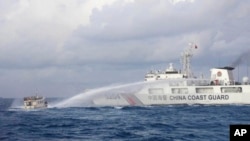High-pressure water cannons knocking out the engines of a tiny Philippine supply boat. Military-grade lasers temporarily blinding the crew of a coast guard ship. And high-seas chases that have resulted in multiple collisions.
Scenes like this have played out regularly in recent months, as China intensifies its harassment of much smaller Philippine vessels in disputed parts of the South China Sea.
The incidents leave little question about China’s vast military edge over the Philippines. But they also reveal the Philippines has something that China does not – a better narrative – according to Commodore Jay Tarriela, a spokesperson for the Philippine coast guard, and one of the public faces of Manila’s new push to expose China’s behavior.
"In terms of optics, [the Chinese] are at a disadvantage," Tarriela told VOA in an interview.
Tarriela is part of a government task force trying to counteract China’s military advantage by weaponizing information.
Philippine officials call the effort a "transparency campaign" – an attempt to shame China by releasing pictures and videos of its harassment in near real-time, and by bringing boatloads of journalists to witness the incidents firsthand.
The initiative has attracted a wave of media attention at home. Chinese harassment is now a hot topic for TV talk shows and local politicians. The Philippines has also received more international support.
However, even Philippine officials admit they do not know if bad PR alone can deter China, which seems increasingly determined to project power in its neighborhood.
Turning point
The South China Sea territorial dispute is not new. The Philippines has long objected to China’s sweeping claims over the strategic waterway, through which $3 trillion of trade passes each year.
The Philippines’ previous government, which pursued closer ties with China, played down tensions at sea.
The turning point came in February, when a Chinese coast guard ship used a laser to disrupt a Philippine resupply mission to an outpost near the Second Thomas Shoal, temporarily blinding some of the crew.
When the Philippine coast guard released video of the laser incident, a wave of local and international headlines followed, creating momentum for the transparency campaign, according to some of those involved in the effort.
Sophisticated tools
Months later, Manila not only releases videos of China’s harassment, it searches for such content, using increasingly sophisticated tools.
Overhead, drones monitor swarms of Chinese ships in disputed areas. Underwater, cameras accompany Philippine coast guard divers as they cut what Manila describes as an illegal barrier meant to block access by Philippine fishermen.
Perhaps most importantly, the Philippine coast guard now embeds crews of Filipino journalists, including some who work for international news outlets, ensuring that the Chinese harassment plays out in front of the world’s TV cameras.
Not only has this given credibility to Philippine government messaging, it also makes lofty geopolitical principles more relatable, said Jonathan Malaya, assistant director general of the Philippines National Security Council.
"We want freedom of navigation. We want a free and open Indo-Pacific and a rules-based international order. [But] these are complex issues that are not near the gut," Malaya told VOA in an interview at his office.
"People won’t understand exactly what they mean unless we show what’s really happening on the sea lanes."
Success at home, abroad
The strategy seems popular in Manila. Media personalities and politicians now routinely discuss maritime sovereignty issues. With the added attention, the Philippine coast guard will receive a budget hike for 2024, allowing it to continue its bolder approach.
International cooperation has also expanded. This year, the Philippines and the United States held their biggest joint military exercise to date. The United States and Australia recently conducted joint patrols with the Philippines in the South China Sea, and Philippine officials say several more nations could soon join similar multilateral missions.
Ties with Japan are also growing. This week, the Philippines installed the first of four Japanese-made air surveillance radar systems to allow Manila to keep a better watch on disputed areas. Soon, the Philippines and Japan hope to reach a deal that would allow the deployment of military forces on each other’s soil.
Meanwhile, a growing number of countries now issue statements of concern and condemnation following each incident of Chinese harassment.
"The Chinese have noticed that, and they’re pissed off, to use the technical term," a U.S. diplomat in the region told VOA. "It just means their efforts to divide and conquer haven’t worked."
Deterrent effect unclear
It is not clear that China feels compelled to act less aggressively at sea, despite making some tactical modifications.
Tarriela, the Philippine coast guard spokesperson, said China has on several occasions withdrawn its so-called "maritime militia" fleet after being exposed.
He also says Chinese coast guard ships now shadow Philippine vessels from behind, rather than side-by-side, as they sometimes did before the transparency campaign began. That makes it easier for Philippine ships to maneuver, Tarriela said.
China is, however, increasing its use of water cannons and dangerous maneuvers, according to Philippine officials.
After the latest water cannon incident earlier this month, China sent 11 vessels inside the Second Thomas Shoal – a possibly unprecedented provocation, according to observers.
"China is escalating," said Ray Powell, a retired U.S. Air Force colonel who now works at Stanford University's Gordian Knot Center for National Security Innovation.
"What remains to be seen is whether the reputational harm China is suffering will bite hard enough to convince them to seek an off-ramp, or whether they believe their current course can convince Manila to veer from its own course," Powell told VOA.
The Philippines has little choice but to continue its current strategy, in the view of Victor Andres Manhit, managing director for the Philippines at advisory firm BowerGroupAsia.
"What else can we do?" he asked. "Because the only other option is to accept China and its aggressiveness."











